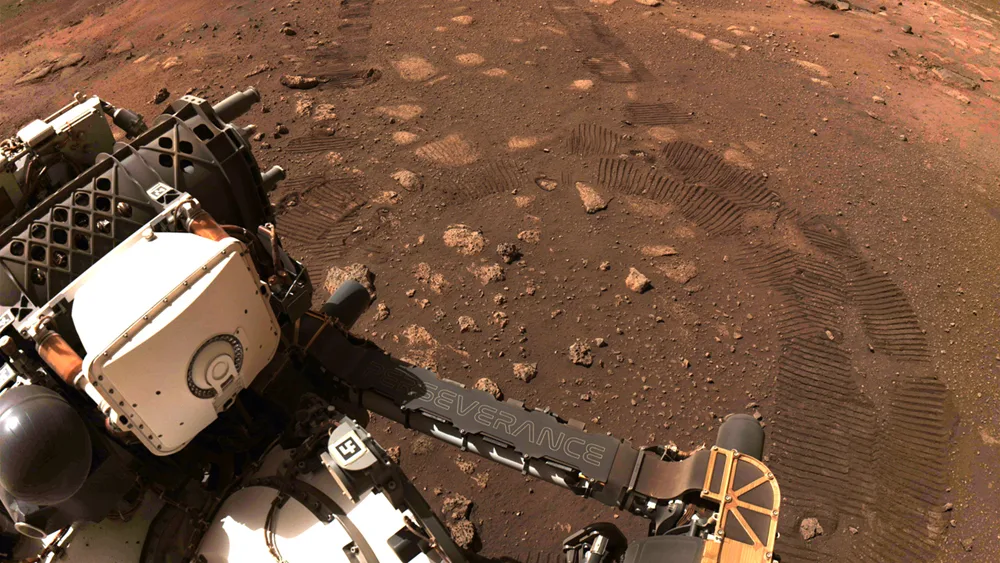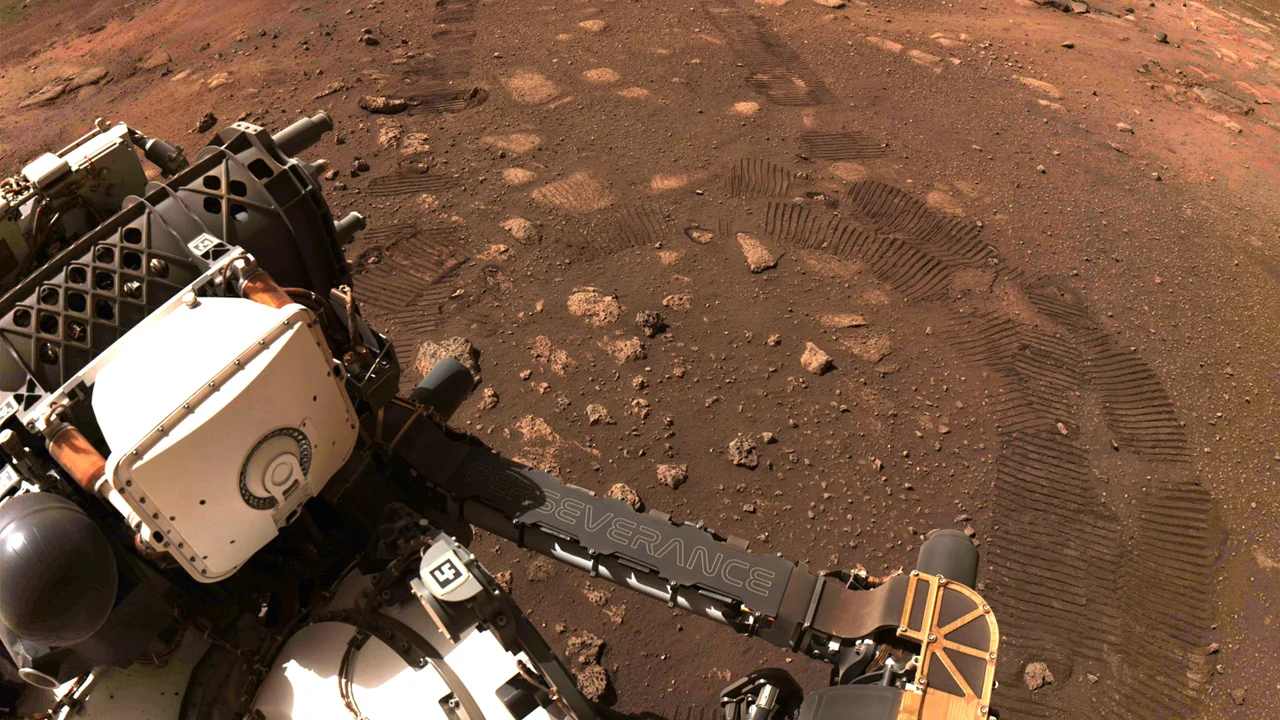
NASA took the Perseverance rover for its first 'spin' on Mars
The rover has logged plenty of 'firsts' since it landed two weeks ago, and even more are happening in the days ahead.
After a short drive on Thursday, NASA's Perseverance rover has now made its first wheel tracks on the surface of Mars. The robot explorer has also racked up a number of other mission 'firsts', while preparing to begin its mission of gathering science from Jezero crater.
We've seen a steady stream of amazing imagery arriving from Perseverance over the past two weeks. From the stunning sequence of its 'seven minutes of terror' landing, to the panoramic views of its surroundings, the mission so far has been a treat for space fans. All this while, though, the mission team has been transitioning the rover from thinking it is a spacecraft on an interplanetary journey, over to the mindset of a geologist and astrobiologist explorer of an alien planet's environment.
In the process, they've been running Perseverance through a list of milestones, activating its various mechanical systems and instruments, and taking the rover for its first spin (literally) in Jezero crater.

Perseverance's navcams snapped pictures of the wheel tracks the rover made during its first drive, on March 4, 2021. Credit: NASA/JPL-Caltech
"When it comes to wheeled vehicles on other planets, there are few first-time events that measure up in significance to that of the first drive," Anais Zarifian, the Perseverance rover mobility test bed engineer at NASA JPL, said in a statement. "This was our first chance to 'kick the tires' and take Perseverance out for a spin. The rover's six-wheel drive responded superbly. We are now confident our drive system is good to go, capable of taking us wherever the science leads us over the next two years."
Although the rover did not take photographs on its drive (one thing at a time, for now!), NASA did release a simulation of the rover's jaunt. After first driving forwards for about 4 metres, Perseverance turned by 150 degrees, and then backed up for another 2.5 metres.
Perseverance's drive system is very similar to Curiosity's, but it has a couple of new features. It has newly redesigned wheels that should minimize damage due to rocks, and it also includes the ability to drive itself. The artificial intelligence installed on the rover will cut down on delays and stops by using the ability to decide for itself what the safest driving route is to its next target destination. The team says that, due to this, they project that Perseverance will be able to drive up to 200 metres per day.
Before that first drive took place, though, Perserverance took the time to deploy some of its instruments, such as the wind sensors mounted on its mast.
These instruments, along with the rest of the Mars Environmental Dynamics Analyzer (MEDA) - the rover's weather station - are now sending back data on the atmospheric conditions. Hopefully we will soon begin to see those readings, in the same way that the InSight lander sends back weather data from Elysium Planitia.
The rover also took the time to flex its arm. The instruments on the end of this arm — SHERLOC, WATSON, and PIXL — are some of the most important ones of the mission. These are what will help the rover find evidence of past Martian life (if it existed).
According to the team, over the course of two hours, the maneuver had the rover extend its arm vertically, as if stretching it towards the sky. They scheduled a few photographs of this, just to show that the arm 'unstowed' properly and that the 'hand' could turn as it should.
"Tuesday's first test of the robotic arm was a big moment for us," Robert Hogg, the Perseverance rover deputy mission manager, said in the NASA statement. "That's the main tool the science team will use to do close-up examination of the geologic features of Jezero Crater, and then we'll drill and sample the ones they find the most interesting. When we got confirmation of the robotic arm flexing its muscles, including images of it working beautifully after its long trip to Mars — well, it made my day."
According to NASA, the rover also checked out, for the first time, two more of its instruments — the Radar Imager for Mars' Subsurface Experiment (RIMFAX) and the Mars Oxygen In-Situ Resource Utilization Experiment (MOXIE).
We are still a few weeks away, perhaps, from Perseverance being fully checked out and ready to go. Even when it's set, though, the first thing on the mission agenda, before any of the science gets done, is still to see if the Mars Helicopter, Ingenuity, will fly. With those test flights still expected sometime in the next month or two, we have a ways to go yet. Time sure is flying when it comes to this mission, though.
LANDING ZONE GETS ITS OFFICIAL NAME
It's a tradition with NASA missions that the landing zone gets an official name. For Perseverance, its landing spot is now named for science fiction author Octavia E. Butler.

The Mars 2020 landing zone in Jezero Crater is named after pioneering science fiction writer Octavia E. Butler (inset). Credit: NASA/JPL-Caltech
"Butler's protagonists embody determination and inventiveness, making her a perfect fit for the Perseverance rover mission and its theme of overcoming challenges," Kathryn Stack Morgan, deputy project scientist for Perseverance, said in the NASA statement. "Butler inspired and influenced the planetary science community and many beyond, including those typically under-represented in STEM fields."
"I can think of no better person to mark this historic landing site than Octavia E. Butler, who not only grew up next door to JPL in Pasadena, but she also inspired millions with her visions of a science-based future," Thomas Zurbuchen, NASA associate administrator for science, said. "Her guiding principle, 'When using science, do so accurately,' is what the science team at NASA is all about. Her work continues to inspire today's scientists and engineers across the globe – all in the name of a bolder, more equitable future for all."






